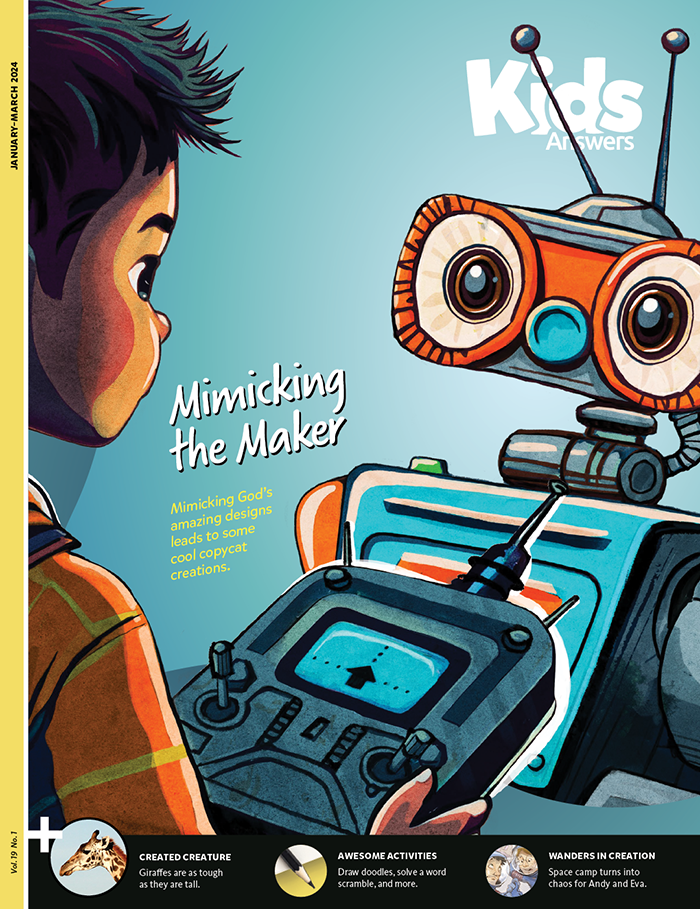Any Way You Slice It
Unlocking Science
by Roger Patterson on January 1, 2024Apples, oranges, bananas, watermelons, strawberries—thousands of fruit varieties sweeten our menu. On day three of creation week, God created plants according to specific kinds. Those kinds would reproduce more of the same kind. That means that apple trees will always produce apples, never oranges or any other kind of fruit.

I’m Roger Patterson, the host of Unlocking Science on Answers TV. Let’s have some fun as we investigate God’s amazing creation.
Botanists (plant scientists) define fruits as the part of a flowering plant that holds the seeds. Not all fruits are safe to eat, but many have delicious fleshy parts.
What do you call a piece of art made by a fruit?
A masterpeach!
God specially designed each fruit to help disperse (spread) the plant’s seeds. Round fruits roll to places where they decompose so the seeds can take root. Animals and birds eat fruits and poo out the seeds in new areas. Some floating fruits, like coconuts and cranberries, disperse their seeds by water. Other fruits are covered with spines or bristles that are carried to new places on animal fur. Some lightweight fruits have wing-like structures that allow them to drift through the air.
What do you call a bunch of strawberries playing instruments together?
A jam session!
We can learn a lot about God’s design for dispersion by examining fruit. Grab your favorite pieces of fruit and get ready to slice and dice—and maybe even munch.
Let’s do it!
What You’ll Need
- Sharp knife
- Tweezers or toothpick
- Cutting board
- 2 apples (or 2 of another kind of large, seeded fruit.)
- Pencil and paper
Parts of the Fruit
- Fruits are covered in a skin called an exocarp.
- The fleshy part inside the skin is called the mesocarp.
- The inside of the fruit that holds the seeds is called the endocarp.
What to Do
- Examine the outside of the fruit. What is the fruit’s color? Shape? Texture? Predict how many seeds you think the fruit will have. Based on the shape and structure of the fruit, how would the seeds most likely spread to grow in new places?
- Ask an adult to help you cut the fruit in half from top to bottom. How many seeds can you see? How are the seeds arranged?
- Sketch one of the halves. On your drawing, label the fruit’s exocarp, mesocarp, and endocarp.
- Now cut the second fruit in half from side to side. Sketch one of the halves and compare this drawing to the first. How does the inside of the fruit and the arrangement of the seeds look different when the fruit is cut different ways? Is the fruit divided into a clear number of sections?
- Use the toothpick or tweezers to carefully remove all the seeds from one of the fruits. How many seeds are there? Set those seeds aside and remove the seeds from the second fruit. Do the two fruits have the same number of seeds?
- If you used clean tools, take a bite of the fruit and describe the taste and texture.
- If you want, try steps 1–5 again with a different kind of fruit. Compare the second kind of fruit with the first.
Fresh Fruit Facts
- Cantaloupe are called “rock melons” in some English-speaking countries.
- If you cut a cucumber, tomato, or pepper, you’ll find seeds inside. Scientifically, that makes them fruit.
- A jalapeño pepper is a fruit—but you probably don’t want to add one to your fruit salad!
What Makes a Fruit a Fruit and a Vegetable a Vegetable?
A fruit develops from a flower. A vegetable is an edible part of a plant that develops from any other part of the plant, such as a root or stem.
Kids Answers Magazine
Mimicking the Maker
Mimicking God’s amazing designs leads to some cool copycat creations.
Browse Kids Issue- © 2024 Answers in Genesis
- Privacy Policy
- Contact
- About

